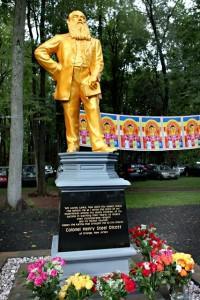Over at The Smart Set, Stefany Ann Golberg has posted a nice piece on Henry Steel Olcott, an American civil war colonel and champion of Sinhalese Buddhism. Olcott was a fascinating character who had major impacts on the construction of Sinhalese Buddhism and Western understandings of that construction.

Henry Steel Olcott Statue in Sri Lanka
It’s a longish article from which I have excised the following for comment:
When Henry Steel Olcott came to Sri Lanka in the late 19th century, his goal was simply to learn more about the Eastern religions he so admired. But somehow, this Presbyterian-born Spiritualist ended up becoming a Buddhist himself and initiating a revival that would sweep throughout Sri Lanka and the entire Buddhist world. Little by little, Henry Steel Olcott became the voice of a religion that had been silenced by colonialism.
By the time Olcott died in 1907, it was clear he had played a crucial role as just such a leader. In Sri Lanka, Henry Steel Olcott would create scores of Buddhist schools, and many more would be built in his name. It was Henry Steel Olcott who initiated the design of the international Buddhist flag, and you see it everywhere in Sri Lanka, from temples to trishaws. His Buddhist Catechism has been translated into more than 20 languages and is still used in Buddhist education all over the world.
The anthropologist Gananath Obeyesekere calls Olcott’s Buddhism “Protestant Buddhism.” It’s not clear just how much present-day Buddhism in Sri Lanka — or Thailand or Cambodia or Laos or Vietnam or Japan or Burma or the United States, where Olcott’s influence was also profound — is “real” Buddhism, as Olcott claimed, or Olcott’s pragmatist interpretation.
Olcott tapped into the most optimistic and motivational aspects of Buddhism, became the white face of a nascent Buddhist movement already stirring in the country. He made a link between a personal independence that could be achieved through Buddhism and a national independence that could be achieved by all Sri Lankans. He promoted this message with an American talent for advertising, and went about the country performing good deeds. It was a magic mix that was destined to light a fire under the Sinhalese.
And today, there is another, more controversial aspect to Olcott’s legacy in the form of a Sinhalese Buddhist Nationalist movement that expounds Buddhism as the country’s one true religion. This idea has proved to be less enthralling to Sri Lanka’s non-Buddhists — notably the Tamils, Sri Lanka’s majority minority, who are primarily Hindu. The connection between Buddhism and Sinhalese nationalism was a major factor in Sri Lanka’s 26-year civil war that ended in 2009.
Olcott went to Sri Lanka to learn about Buddhism. Not able to find it, or at least not finding what he expected or wanted, he constructed his own syncretic version. Olcott’s vision was then appropriated by Sri Lankans (and others) for their needs and purposes. This dialectic is not unique to Sinhalese Buddhism or Olcott’s Buddhism.
All religions are constantly being appropriated, revised, imagined, and constructed. Religions are never static and there are no “pure” or “authentic” forms.

